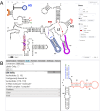This is a preprint.
R2DT: A COMPREHENSIVE PLATFORM FOR VISUALISING RNA SECONDARY STRUCTURE
- PMID: 39803519
- PMCID: PMC11722224
- DOI: 10.1101/2024.09.29.611006
R2DT: A COMPREHENSIVE PLATFORM FOR VISUALISING RNA SECONDARY STRUCTURE
Update in
-
R2DT: a comprehensive platform for visualizing RNA secondary structure.Nucleic Acids Res. 2025 Feb 8;53(4):gkaf032. doi: 10.1093/nar/gkaf032. Nucleic Acids Res. 2025. PMID: 39921562 Free PMC article.
Abstract
RNA secondary (2D) structure visualisation is an essential tool for understanding RNA function. R2DT is a software package designed to visualise RNA 2D structures in consistent, recognisable, and reproducible layouts. The latest release, R2DT 2.0, introduces multiple significant features, including the ability to display position-specific information, such as single nucleotide polymorphisms (SNPs) or SHAPE reactivities. It also offers a new template-free mode allowing visualisation of RNAs without pre-existing templates, alongside a constrained folding mode and support for animated visualisations. Users can interactively modify R2DT diagrams, either manually or using natural language prompts, to generate new templates or create publication-quality images. Additionally, R2DT features faster performance, an expanded template library, and a growing collection of compatible tools and utilities. Already integrated into multiple biological databases, R2DT has evolved into a comprehensive platform for RNA 2D visualisation, accessible at https://r2dt.bio.
Conflict of interest statement
CONFLICT OF INTEREST None declared.
Figures






References
-
- Cannone J.J., Subramanian S., Schnare M.N., Collett J.R., D’Souza L.M., Du Y., Feng B., Lin N., Madabusi L.V., Müller K.M., et al. (2002) The Comparative RNA Web (CRW) Site: an online database of comparative sequence and structure information for ribosomal, intron, and other RNAs. BMC Bioinformatics, 3, 1–31. - PMC - PubMed
-
- Ponty Y. and Leclerc F. (2015) Drawing and editing the secondary structure(s) of RNA. Methods Mol. Biol., 1269, 63–100. - PubMed
-
- Sieg Jacob P., Forstmeier Peter C., Philip C. Bevilacqua R2easyR.
Publication types
Grants and funding
LinkOut - more resources
Full Text Sources
